As an Amazon Associate KitchenwareSets.com earns from qualifying purchases.
7 Stunning Open Kitchen Layouts That Create Perfect Flow
Do you ever feel like you’re stuck in a “cooking cave” while the rest of the family is laughing and living in the next room? You can hear the fun, but you’re separated by a wall, juggling pots and pans, and missing out on the conversation. It’s a common frustration in homes with traditional, closed-off kitchens—a design that can make the cook feel isolated and the home feel disconnected.
This sense of separation is a remnant of older architectural styles. But modern living calls for connection, flow, and shared experiences. Updated for 2025, the solution that has transformed countless homes is the open kitchen design, a concept first popularized by visionary architects like Frank Lloyd Wright who sought to break down physical barriers to create more unified, human-centric living spaces.
An open kitchen design is a layout where walls between the kitchen and adjacent living or dining areas are removed. This creates a single, integrated space that enhances social interaction, improves traffic flow, and creates a brighter, more expansive feel in the home. It’s not just a design trend; it’s a lifestyle upgrade that turns the kitchen from a secluded utility room into the true, vibrant heart of the home.
Feeling Disconnected in Your Own Home? How an Open Kitchen Can Bring Everyone Together
The shift toward open kitchen layouts is one of the most significant changes in modern home aesthetics. By knocking down the literal and figurative walls that separate the kitchen from the rest of the house, you create a dynamic environment that fosters connectivity and enhances your home’s overall feel and function. It’s about creating a space where cooking a meal and hosting a party can happen all at once, without missing a single moment.
The Core Benefits: More Than Just Removing a Wall
The tangible advantages of an open-concept kitchen extend far beyond just aesthetics. It’s a strategic design choice that improves daily life and can even increase the value of your home.
- Enhanced Social Interaction: This is the number one reason people choose an open layout. It allows the person cooking to remain part of the conversation, help kids with homework at the island, or chat with guests while finishing meal prep. It transforms cooking from a solitary chore into a shared activity.
- Increased Space and Light: Removing walls allows natural light from windows in the living or dining room to flood the entire area, making the space feel significantly larger, brighter, and more airy. This is especially impactful in smaller homes or apartments.
- Improved Traffic Flow: Without walls and doorways creating bottlenecks, people can move freely between the kitchen, dining, and living zones. This creates an effortless flow that is ideal for both everyday family life and entertaining larger crowds.
- Higher Resale Value: Open-concept layouts are consistently one of the most sought-after features for homebuyers. A well-designed open kitchen is a major selling point that can significantly boost your property’s appeal and resale value.
Smart Strategies for a Flawless Open Kitchen
To manage an open kitchen effectively, create distinct zones with lighting and flooring, use a powerful range hood to control odors, maintain a cohesive color palette across spaces, and prioritize closed storage like pantries and deep drawers to keep clutter hidden. While the benefits are huge, a successful open design requires smart planning to mitigate the potential downsides.
I’ve learned from experience that the biggest challenges are managing noise, smells, and the ever-present visibility of mess. Here’s how to tackle them head-on:
- Define Zones Without Walls: You can create visual separation using clever design tricks. Use different flooring (like tile in the kitchen and wood in the living area), hang pendant lights over the island to define the kitchen zone, or strategically place a large area rug to anchor the living room furniture.
- Invest in Powerful Ventilation: This is non-negotiable. A high-quality, quiet range hood is essential for preventing cooking smells, smoke, and grease from permeating your entire living space and clinging to furniture.
- Maintain a Cohesive Aesthetic: Because the kitchen is always visible, its design must harmonize with the adjoining living and dining areas. Use a unified color palette, consistent flooring, and complementary hardware and finishes to create a seamless, intentional look.
- Prioritize Smart Storage: Clutter is the enemy of an open kitchen. Invest in clever, concealed storage solutions. Think deep drawers for pots and pans, a floor-to-ceiling pantry for dry goods, and appliance garages to hide the toaster and blender. The tidier it is, the more serene the entire space will feel.
7 Stunning Open Kitchen Layouts That Create Perfect Flow
Now for the fun part: inspiration! Choosing the right layout is the key to unlocking the full potential of your open kitchen design. The perfect layout depends on your home’s footprint, your family’s needs, and how you want to live in the space.
We’ve curated 7 proven layouts used by top interior designers. Each one is adaptable and solves common design challenges to create a space that is not only beautiful but incredibly functional. From the classic social island to clever solutions for narrow homes, you’ll find an idea here that sparks your imagination.
1. The Classic L-Shaped Kitchen with a Social Island
The most popular and versatile open kitchen layout is the L-shaped kitchen with a large central island, as it creates an efficient work zone while establishing the island as the home’s primary social hub.
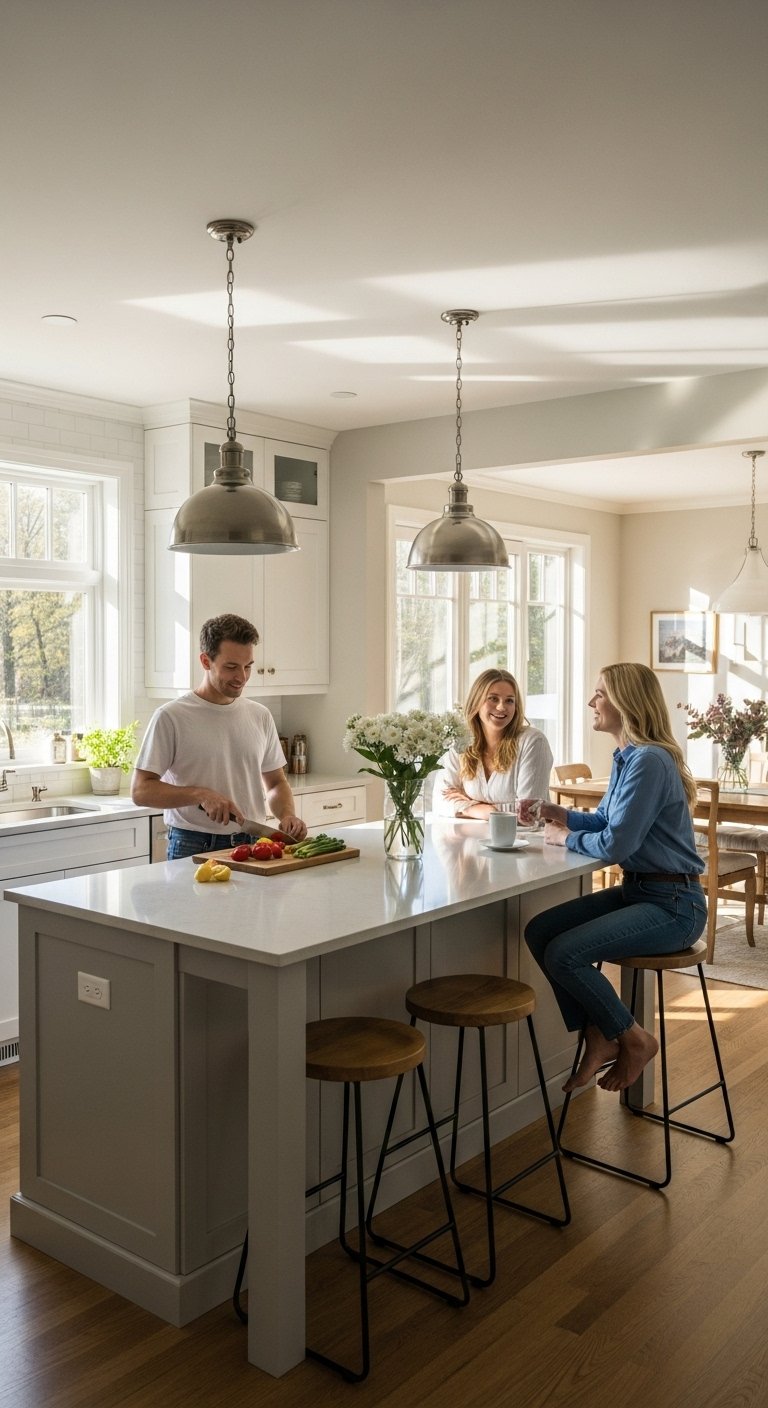
- Key Elements: Cabinetry and appliances are arranged along two adjacent walls, forming an “L.” A large, stationary island sits in the center, facing the open living or dining area.
- Design Strategy:
- Place your major appliances (refrigerator, stove, and sink) in a classic work triangle configuration across the two walls and the island. This minimizes steps and maximizes cooking efficiency.
- Design the island with a countertop overhang on the side facing the living area. This creates a comfortable and inviting breakfast bar for casual meals and conversation.
- Install a set of beautiful pendant lights above the island. This not only provides crucial task lighting but also visually anchors the island as the room’s focal point.
Pro-Tip: Ensure at least 42-48 inches of clearance on all sides of the island. This is a critical detail experts always consider to allow for comfortable traffic flow and to ensure that appliance doors (like the oven and dishwasher) can open fully without obstruction.
Pin this classic layout for your dream kitchen board!
2. The Space-Saving One-Wall Kitchen with a Movable Island
For smaller homes or studio apartments, the one-wall kitchen with a movable island provides maximum flexibility by consolidating all functions onto one wall and using a versatile, non-permanent island for prep space.
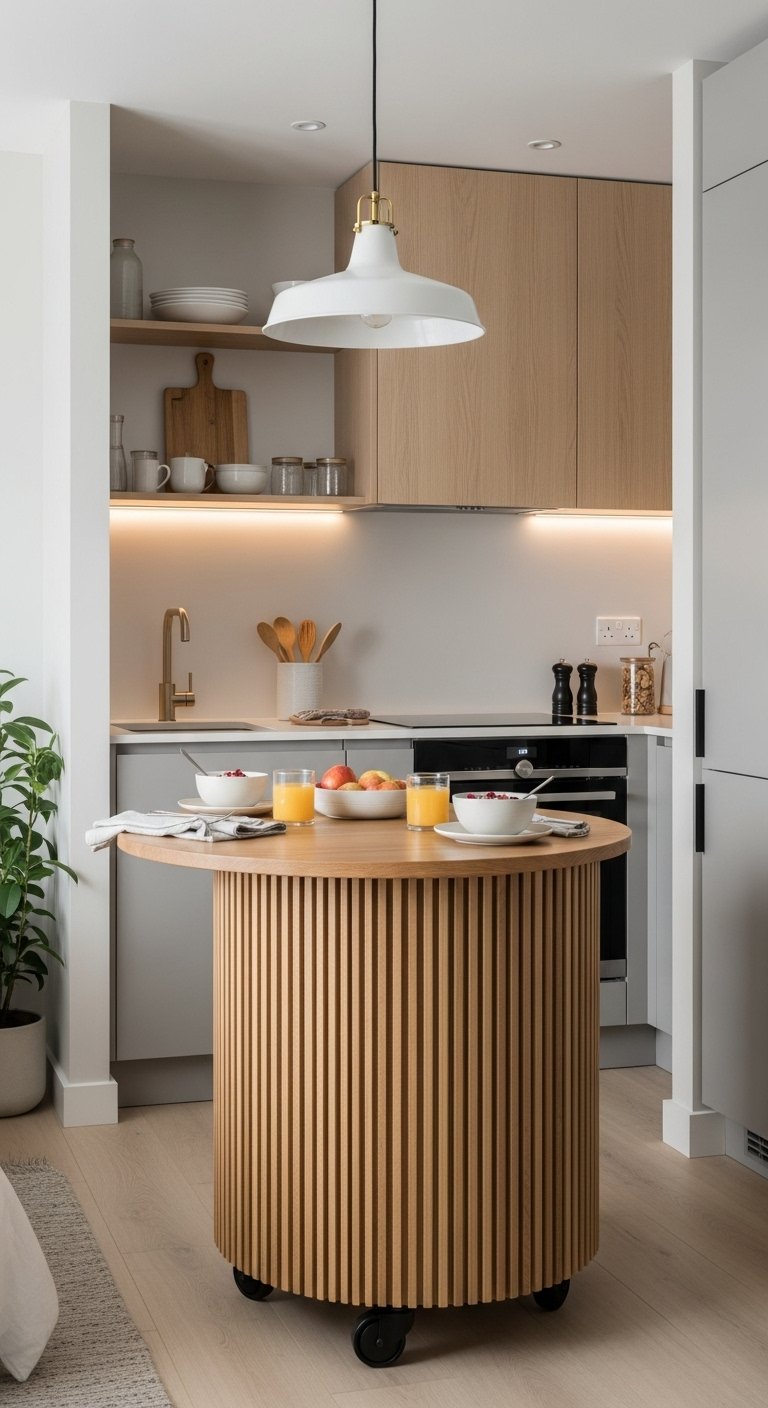
- Key Elements: All cabinets, countertops, and appliances are installed along a single wall. A freestanding kitchen island or cart, often on casters, provides additional workspace.
- Design Strategy:
- Maximize your storage by using vertical space. Install floor-to-ceiling cabinetry or tall pantry units to compensate for the smaller horizontal footprint.
- Select a movable island on wheels. This brilliant piece can be used as a prep station, a serving buffet, or can be pushed to the side to create more open floor space when entertaining.
- Incorporate reflective surfaces to make the space feel larger. A glossy backsplash, polished chrome hardware, or stainless steel appliances will bounce light around the room.
Lesson Learned: In a true one-wall kitchen, a movable island is more than just extra counter space; it’s a flexible boundary that can define the kitchen area during meal prep and disappear when you need an open floor for a party.
Love this small-space solution? Save it for later!
3. The Modified U-Shaped Kitchen with a Peninsula Bar
A modified U-shaped kitchen uses a peninsula to provide the ample counter space of a U-shape while maintaining a vital connection and sightline to the adjacent dining or living room.
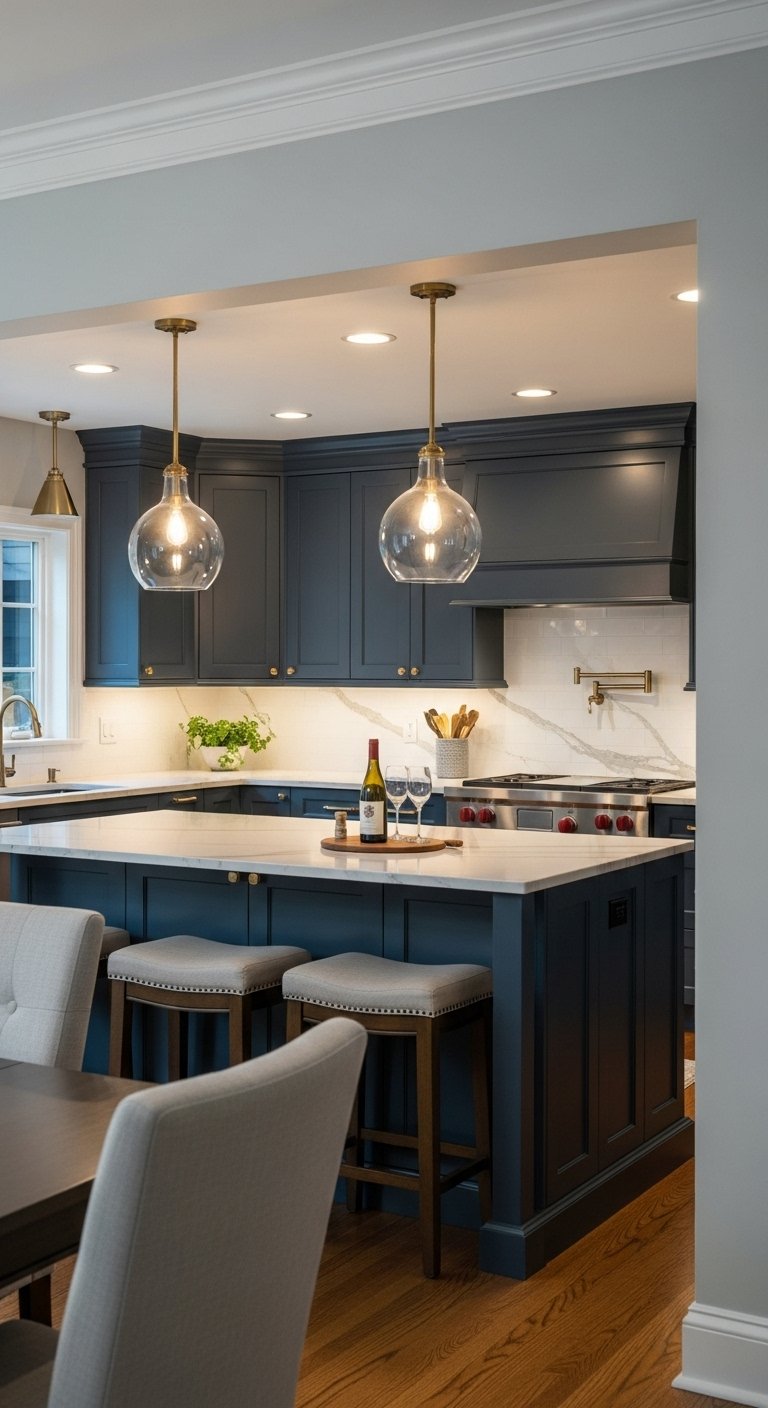
- Key Elements: Cabinetry and appliances run along three sides, but one arm of the “U” is a peninsula that extends into the open space instead of a full wall.
- Design Strategy:
- Design one leg of a traditional U-shaped kitchen as a peninsula, which can be either counter-height or a taller bar-height.
- Extend the countertop on the outer side of the peninsula to create an overhang. Tuck bar stools underneath to form an integrated breakfast bar and a perfect spot for guests to gather.
- This layout naturally creates a protected and efficient work zone for the cook, keeping traffic out of the way while still allowing for easy conversation.
Pro-Tip: A peninsula is an excellent way to add seating and counter space without requiring the large clearance of a central island, making it a perfect solution for medium-sized open-concept homes.
The perfect blend of open and defined! Pin this idea now.
4. The Opened-Up Galley Kitchen for Narrow Homes
To make a traditionally enclosed galley kitchen feel open, remove the upper portion of one wall to create a large pass-through, which connects the narrow space to an adjacent room and floods it with light.
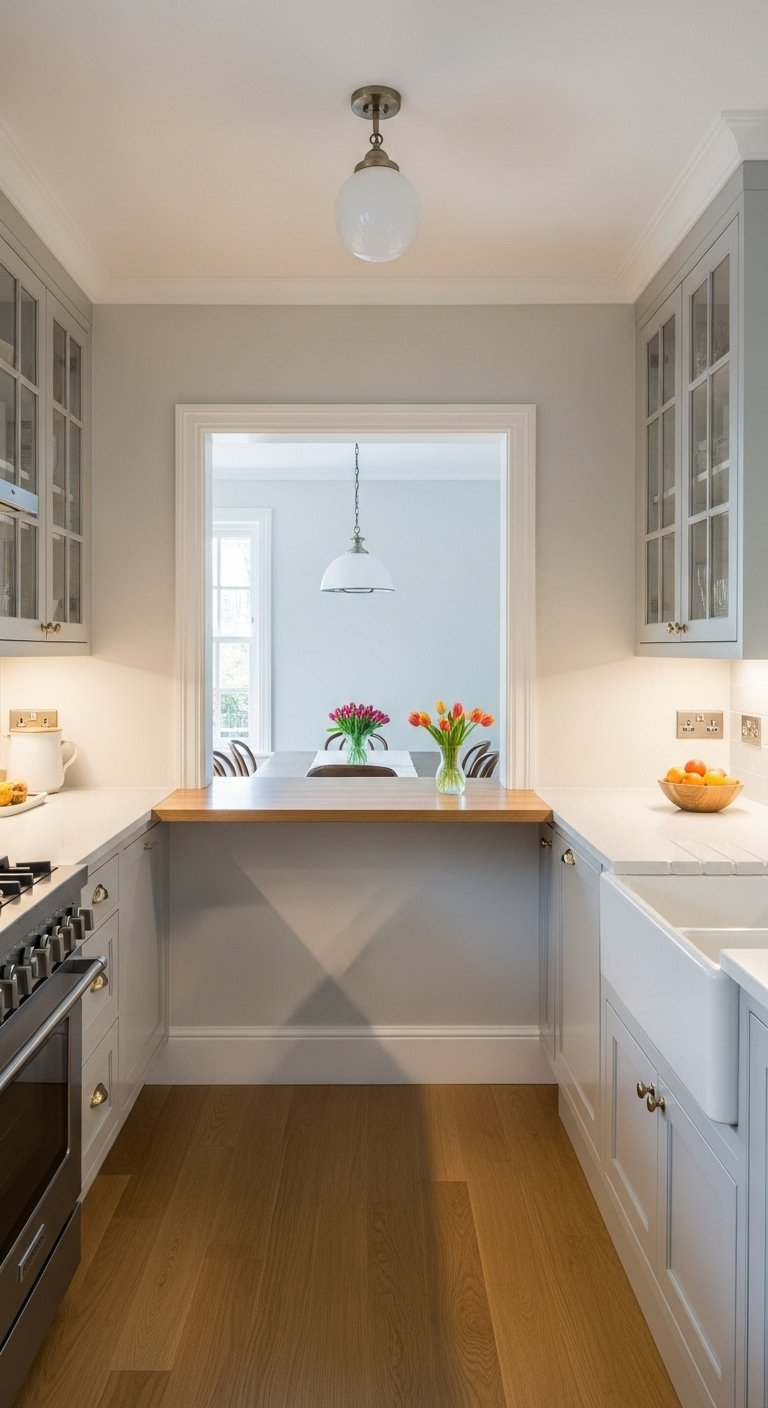
- Key Elements: Two parallel runs of cabinets, with one of the dividing walls either completely removed or opened up into a large pass-through.
- Design Strategy:
- Identify a non-load-bearing wall on one side of the galley. Remove the entire wall or, more commonly, just the top half to create a wide opening.
- Convert the remaining lower portion of the wall into a functional counter or bar top that serves the adjoining living or dining room, creating a convenient pass-through for food and drinks.
- Use a light, consistent color palette and flooring across both spaces to trick the eye into seeing one single, larger room.
Lesson Learned: Before you grab a sledgehammer, always consult a structural engineer. If the wall is load-bearing, you can often still achieve the open feel safely by installing a supportive header beam to create a large cased opening.
See how a galley kitchen can feel spacious! Save this pin.
5. The Great Room: Seamlessly Blending Kitchen, Dining, and Living
A true great room layout relies on a consistent design aesthetic, unified color scheme, and strategic furniture placement to create a harmonious and seamless flow between all three zones.
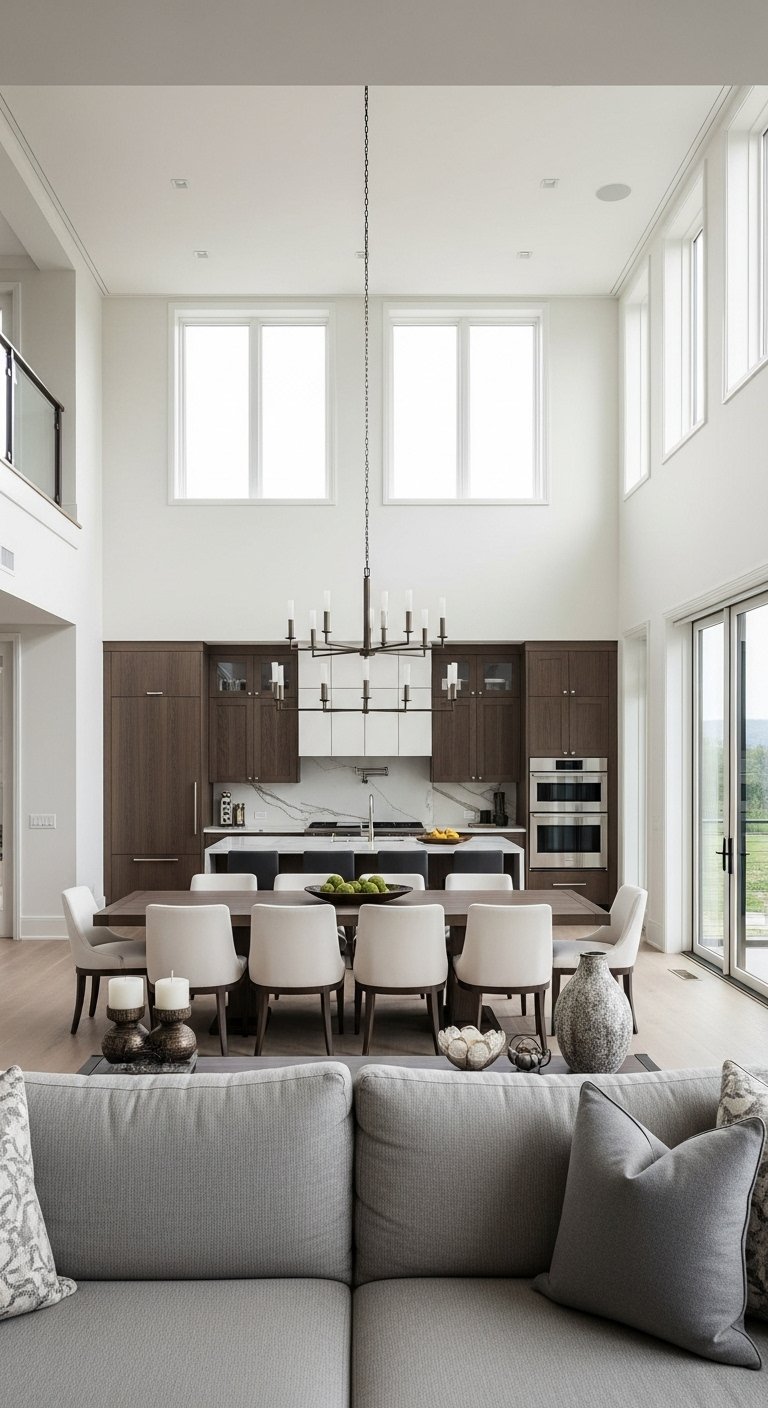
- Key Elements: A single, expansive room that contains the kitchen, dining area, and living area without any structural dividers like walls or columns.
- Design Strategy:
- Establish a unified color palette for the entire room. Start with a primary neutral on the walls and bring in 2-3 accent colors through textiles (pillows, rugs), artwork, and decor across all three zones.
- Use a single flooring material, like hardwood or luxury vinyl plank, throughout the entire great room to create an unbroken visual flow.
- Arrange furniture to create distinct “zones” and clear traffic paths. For instance, placing a sofa with its back to the kitchen island subtly defines the start of the living area.
Pro-Tip: In a great room, lighting is your best tool for zoning. Use a dramatic chandelier over the dining table, functional pendants over the kitchen island, and softer, ambient floor and table lamps in the living area to create different moods and define each zone.
Dreaming of a great room? Pin this inspiration!
6. The Zoned Approach: Defining Areas with Flooring and Lighting
You can create powerful visual separation in an open layout by using flooring transitions, distinct lighting schemes, and large area rugs to define functional zones without building a single wall.
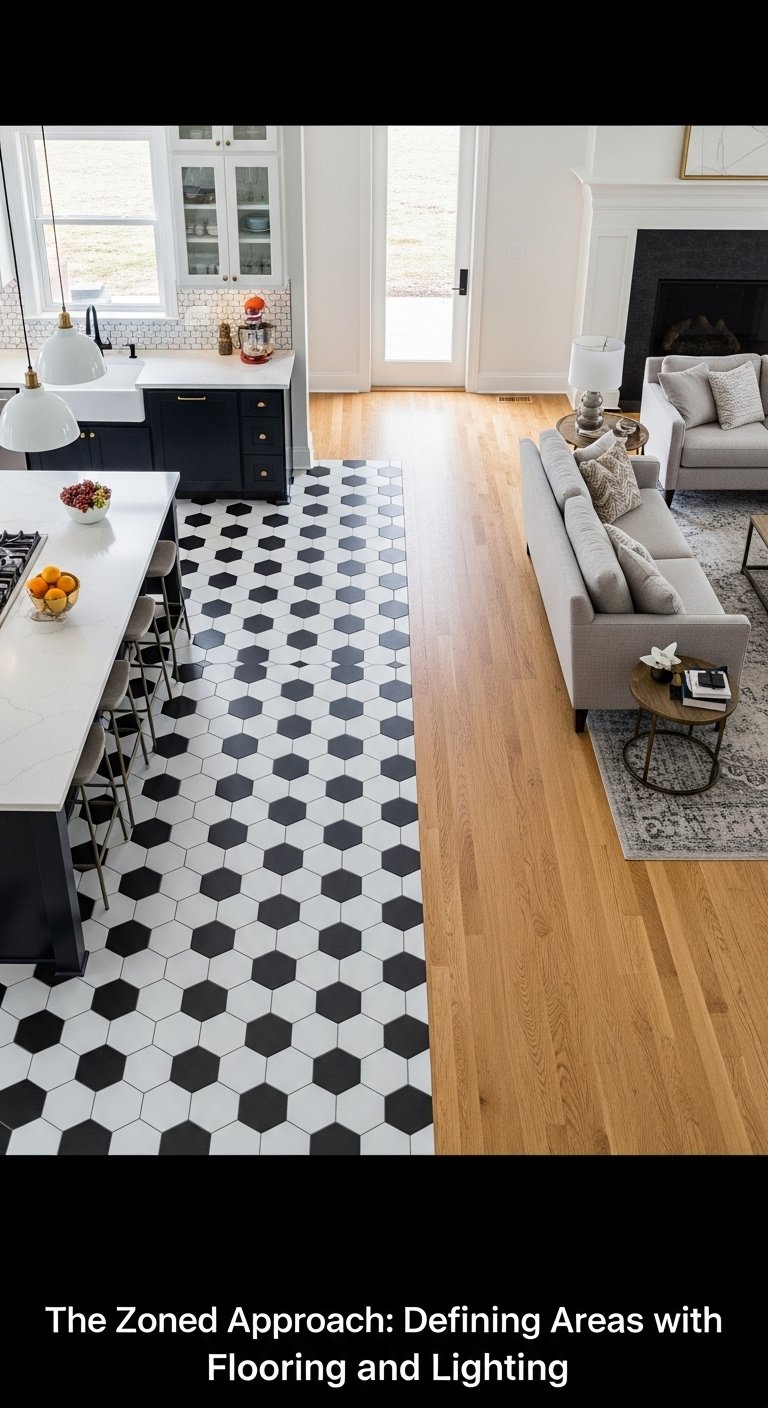
- Key Elements: Varied flooring materials (e.g., tile and wood), strategically placed lighting fixtures, and large area rugs.
- Design Strategy:
- Use a highly durable and water-resistant flooring like porcelain tile in the high-traffic kitchen area, then transition to a softer material like hardwood or carpet in the living space. A popular high-style choice is hexagonal tile that “bleeds” into wood planks for a seamless yet distinct transition.
- Install bright, task-oriented lighting (pendants, recessed lights, under-cabinet strips) in the kitchen and more ambient, decorative lighting (chandeliers, floor lamps) in the dining and living zones.
- Place a large area rug in the living area. This not only adds comfort and style but also acts as a clear visual anchor for the seating arrangement, separating it from the kitchen’s hard flooring.
Lesson Learned: A common mistake is using lighting that is too uniform. Varying the type and intensity of light is one of the most powerful and professional ways to create intimacy and define function in separate zones of a single open room.
Get creative with zones! Save this clever design tips.
7. The Architectural Divide: Using Half-Walls or Glass Partitions
For those who want separation without isolation, a half-wall or a glass partition can block noise and define the space while preserving the crucial sightlines and light-sharing benefits of an open concept.
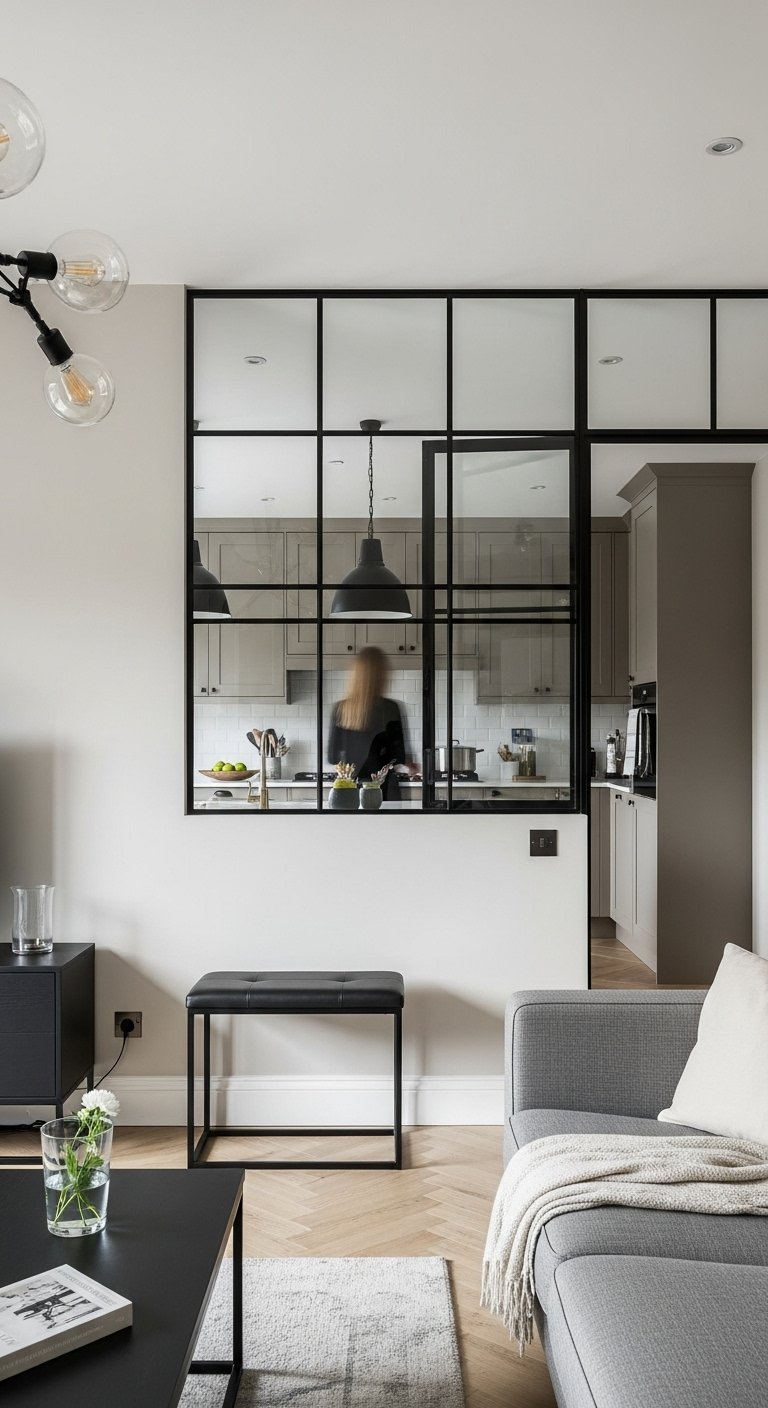
- Key Elements: A low-profile wall (half-wall), a framed glass and steel partition, or a functional piece of furniture like a bookcase.
- Design Strategy:
- Build a half-wall between the kitchen and living area, often topped with a countertop to double as a breakfast bar or serving ledge.
- Install a floor-to-ceiling glass and metal-framed partition (often called a Crittall-style wall). This is brilliant for blocking noise and cooking odors far more effectively than a fully open plan, while maintaining 100% visual connection.
- Use a large, open-backed bookshelf as a room divider. It subtly separates the space while providing valuable storage and display opportunities that can be accessed from both sides.
Pro-Tip: A half-wall is a fantastic place to hide functionality. You can install electrical outlets on the living room side for lamps and electronics, or build in shallow cabinets on the kitchen side for spices or glassware.
Want the best of both worlds? Pin this partition idea!
Key Takeaways: Your Quick Guide to a Perfect Open Kitchen Design
Feeling overwhelmed? Don’t be. Creating a successful open kitchen comes down to a few core principles. Keep these key takeaways in mind as you plan.
- The Island is King: An island is the ultimate multi-tasker, providing workspace, storage, seating, and a natural social hub. It’s the anchor of most successful open-plan kitchens.
- Zone with Purpose: Use flooring, lighting, and furniture placement to create distinct functional areas for cooking, dining, and living, even without walls.
- Ventilation is Non-Negotiable: Invest in a powerful but quiet range hood to prevent cooking smells and grease from traveling throughout your home.
- Create Cohesion: Unify the entire open space with a consistent color palette and complementary materials for a harmonious, high-end look.
- Conceal the Clutter: Prioritize smart, closed storage solutions like pantries, deep drawers, and appliance garages to keep your always-visible kitchen looking tidy.
People Also Ask About Open Kitchen Design
What is an open kitchen design?
An open kitchen design removes the walls between the kitchen and adjacent dining or living areas, creating one large, multi-functional room. This layout promotes social interaction, enhances the sense of space and light, and is a highly sought-after feature in modern homes for its ability to create better traffic flow and a more connected family environment.
What are the disadvantages of an open kitchen?
The primary disadvantages of an open kitchen include the spread of cooking odors, noise from appliances, and visible clutter. Since the kitchen is always on display, messes can’t be easily hidden. These challenges can be mitigated with a powerful range hood, quieter appliances, and smart, ample storage solutions to maintain a tidy appearance.
How do you arrange a house with an open kitchen?
Arrange an open-concept house by creating distinct “zones.” Use a large area rug to anchor the living room furniture, position a sofa with its back to the kitchen to create a soft boundary, and use specific lighting (like a chandelier over the dining table and pendants over the island) to define each area’s function and atmosphere.
What is the 3×4 kitchen rule?
The 3×4 kitchen rule is a design principle suggesting a kitchen should have three separate countertop areas, each about four feet long, to accommodate the three main stages of meal creation: food preparation, cooking, and cleaning. This concept is closely related to the kitchen work triangle and aims to create a highly efficient and organized workspace.
Final Thoughts
An open kitchen layout does more than just update your home’s aesthetic; it can fundamentally change how you interact, entertain, and live in your space. It’s a commitment to a more connected, fluid, and shared way of life. By choosing the right layout for your home and incorporating smart design strategies to manage the practicalities, you can create a beautiful, functional, and flowing heart for your home that brings everyone together.
Which of these layouts sparked an idea for your own space? Let us know in the comments below
